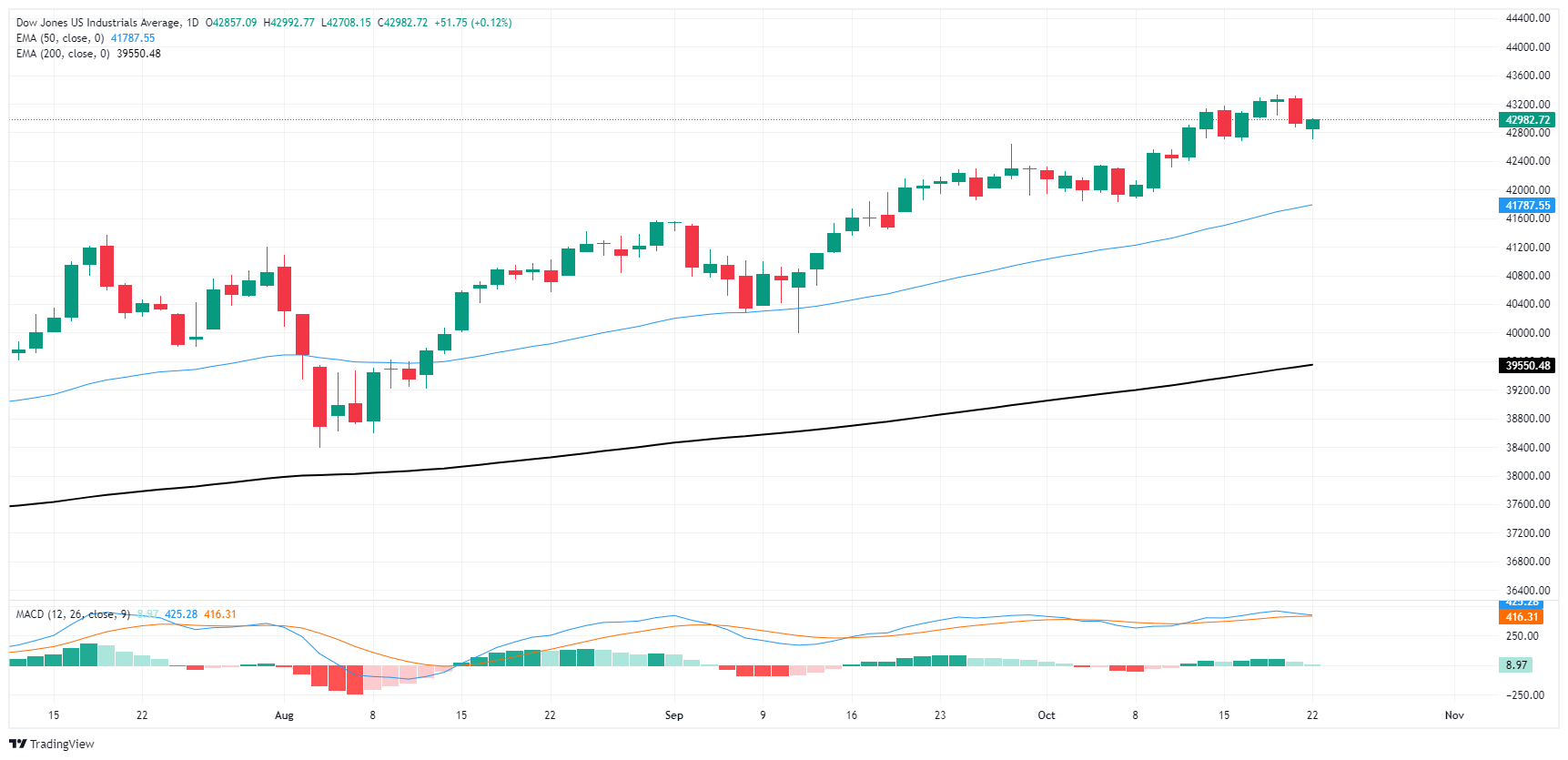- The Dow Jones waffled near the 43,000 handle on Tuesday.
- Equities are grappling with an uptick in yields.
- A lack of confident tone from Fed officials leaves stocks hanging in overbought territory.
The Dow Jones Industrial Average (DJIA) struggled to find its feet near the 43,000 handle on Tuesday. The major index pulling into the midrange as bulls struggled to respond to a near-term decline that kicked off the trading week.
Earnings season is well underway, helping to bolster investor confidence enough to keep losses contained despite equity prices trading deep into overbought territory and most of the market’s favored stocks trading at eye-watering ratios. Equity giants Tesla (TSLA) and Coca-Cola (COKE) will report Q3 earnings on Wednesday, with Honeywell (HON) slated for Thursday.
On Tuesday, General Motors (GM) and Philip Morris (PM) handily beat Wall Street expectations, raising their full-year earnings guidance. Meanwhile, Verizon (VZ) flubbed its latest earnings call, with revenue missing expectations.
Dow Jones news
Despite a cautious start to the day, roughly two-thirds of the Dow Jones are trading into the green on Tuesday. Microsoft (MSFT) rose 2.3% to $428.50 per share, followed by retail giant Walmart (WMT), which gained 1.5% to touch $82 per share. On the low side, Verizon (VZ) crumpled 4.5%, declining below $42 per share after flubbing earnings expectations.
Dow Jones price forecast
Despite a near-term pullback, the Dow Jones remains in a firmly bullish pattern, with the major equity index trading well above its 50-day and 200-day Exponential Moving Averages (EMA) at 41,788 and 39,453, respectively. DJIA prices have been grinding higher since August’s swing low into 38,400, adding nearly 13% bottom-to-top.
The Moving Average Convergence-Divergence (MCAD) is breaking the needle printing in bullish territory, however a contracting histogram is hinting at slowing bullish momentum that has been underpinning the Dow Jones for most of 2024. Despite a deep overbought print on the MACD, potential for downside price action remains limited with the Dow Jones poised for a sixth consecutive month in the green.
Dow Jones daily chart
Dow Jones FAQs
The Dow Jones Industrial Average, one of the oldest stock market indices in the world, is compiled of the 30 most traded stocks in the US. The index is price-weighted rather than weighted by capitalization. It is calculated by summing the prices of the constituent stocks and dividing them by a factor, currently 0.152. The index was founded by Charles Dow, who also founded the Wall Street Journal. In later years it has been criticized for not being broadly representative enough because it only tracks 30 conglomerates, unlike broader indices such as the S&P 500.
Many different factors drive the Dow Jones Industrial Average (DJIA). The aggregate performance of the component companies revealed in quarterly company earnings reports is the main one. US and global macroeconomic data also contributes as it impacts on investor sentiment. The level of interest rates, set by the Federal Reserve (Fed), also influences the DJIA as it affects the cost of credit, on which many corporations are heavily reliant. Therefore, inflation can be a major driver as well as other metrics which impact the Fed decisions.
Dow Theory is a method for identifying the primary trend of the stock market developed by Charles Dow. A key step is to compare the direction of the Dow Jones Industrial Average (DJIA) and the Dow Jones Transportation Average (DJTA) and only follow trends where both are moving in the same direction. Volume is a confirmatory criteria. The theory uses elements of peak and trough analysis. Dow’s theory posits three trend phases: accumulation, when smart money starts buying or selling; public participation, when the wider public joins in; and distribution, when the smart money exits.
There are a number of ways to trade the DJIA. One is to use ETFs which allow investors to trade the DJIA as a single security, rather than having to buy shares in all 30 constituent companies. A leading example is the SPDR Dow Jones Industrial Average ETF (DIA). DJIA futures contracts enable traders to speculate on the future value of the index and Options provide the right, but not the obligation, to buy or sell the index at a predetermined price in the future. Mutual funds enable investors to buy a share of a diversified portfolio of DJIA stocks thus providing exposure to the overall index.
Read More: Dow Jones cautiously tests higher ground after early-week downturn
